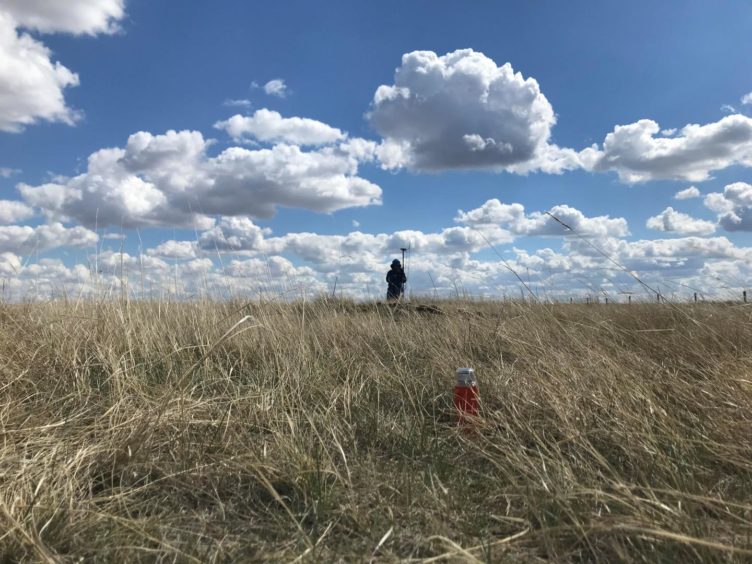
Pioneering seismic technology provider STRYDE today announced its Nodes were used in conjunction with Explor PinPoint technology to achieve a new global record in land seismic trace density at the Carbon Management Canada (CMC) Field Research Station.
STRYDE, Explor and CMC are collaborating to demonstrate the suitability of these ground-breaking technologies for carbon capture, utilisation & storage (CCUS) project development and monitoring.
In this field test, STRYDE, Explor and CMC are demonstrating how STRYDE’s Nodes – the lightest, fastest, and most cost effective on the market – in combination with Explor’s market-leading PinPoint source can be used to map out and monitor the subsurface for CO2 injection without the need for clearing the area or compromising on data quality. The 1 km2 field test has delivered a new world record of over 256 million traces / km2.
This record was achieved by a field team of only ten people, demonstrating the agility of both the STRYDE Nodes and the PinPoint source system. A single two-person team was consistently able to layout up to 1,000 nodes in a day.
Climate models indicate a critical role for CCUS in climate mitigation efforts. The most recent Sustainable Development Scenario by the International Energy Agency attributes 15% of cumulative emissions reduction to CCUS. However, despite current investment in CCUS and significant projected growth, experts say the rate of development for CCUS projects is still not on track to keep emissions below international targets.
There is also growing stakeholder and investor pressure on the fossil energy industry to drive down emissions. Technologies that reduce the cost of CCUS development and monitoring will help these companies to support new growth in total CCUS capacity and thereby achieve net zero emissions targets.
Subsurface monitoring is critical to the secure operation of any CCUS facility, but faces several challenges, including cost and space. As storage projects are usually built near existing infrastructure, subsurface image quality is hampered by the constraints of costly and cumbersome legacy seismic acquisition technology and methods. As a result, many previous CCUS projects have struggled to produce high quality subsurface imaging due to the wide spacing between seismic nodes and constraints over source positioning.
Mike Popham, CEO of STRYDE, said: “As a business, we are committed to the rapid and collaborative development of exceptional and accessible high-definition seismic solutions. We believe that CCUS has a huge role in enabling the world to tackle global CO2 levels. Put simply, we are making high density seismic acquisition accessible for CCUS developers, which will help drive the uptake of this crucial technology.”
In this field test, STRYDE’s Nodes and Explor’s source are being trialled against alternative monitoring technologies, such as distributed acoustic sensing (DAS) and other geophone products, with the final dataset to be compared to a previous 3D survey that was undertaken using a conventional seismic layout with a buggy-mounted vibratory source.
Allan Châtenay, President of Explor said: “Our collaboration with STRYDE and CMC is changing the game for subsurface imaging in support of CCUS, and we are proud to have achieved trace density 2.5 times the previous Canadian record. We are delighted with the performance of our next generation PinPoint system, which weighs less than 2 kilograms and can fit in your pocket. The agility and cost-efficiency of this system is driving a step-change in imaging the subsurface and sets a new benchmark for what can be achieved for CCUS.”
Don Lawton, Director, Carbon Management Canada said: “The scaling down of the size and cost of seismic technology has opened up so much potential for making both development and ongoing monitoring affordable. The data we can collect from seismic acquisition is incredibly important for continually refining CCUS technology, improving storage efficiency, and reducing risk”
“This record-breaking high density has allowed us to accurately model the very shallow subsurface. In prior tests with 3D seismic imaging with wide line spacing, the data for shallow depths cannot be used – ultimately preventing us from exploring what could be valuable information. The density that we can achieve using STRYDE and Explor really opens up new possibilities for a range of geotechnical purposes.”
STRYDE, CMC, and Explor plan to make data from the demonstration project available under a no-cost license to academic institutions to help drive scientific research and technology development. Datasets will also be available to license for companies who are considering CCUS.